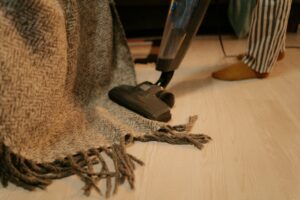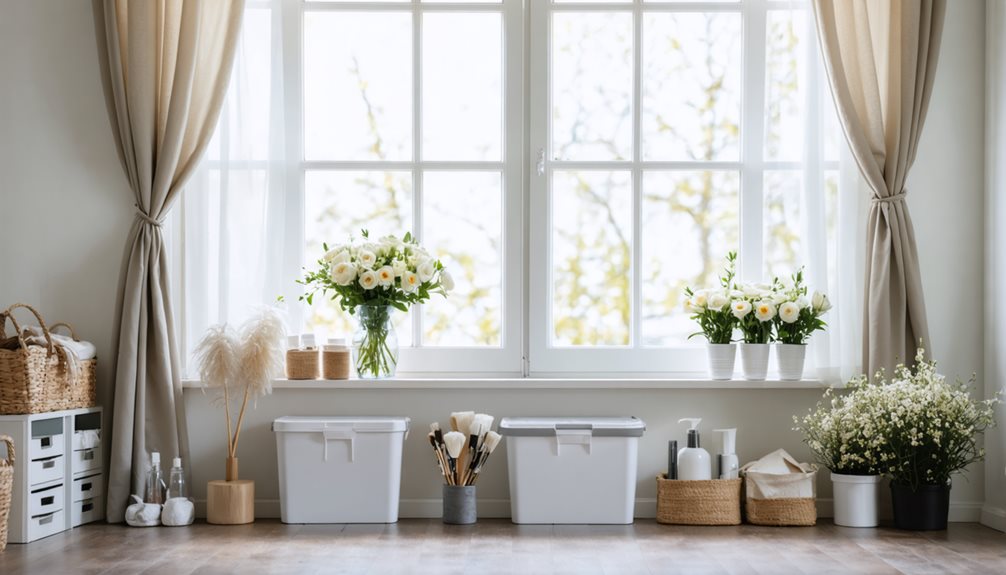Professional spring cleaning starts with a structured approach. Begin by evaluating each room’s needs and creating a prioritized task list. Establish sorting stations for efficient decluttering, following the one-year rule to eliminate unused items. Stock essential cleaning tools, including microfiber cloths, HEPA-filtered vacuums, and all-purpose cleaners. Work systematically from top to bottom in each space, ensuring thorough coverage of surfaces and proper ventilation. Implement weekly maintenance schedules and daily cleaning habits to preserve results. These proven strategies transform overwhelming cleaning projects into manageable tasks, with expert techniques offering even more ways to maximize efficiency.
Key Takeaways
- Start with a room-by-room assessment and create a prioritized cleaning checklist to prevent feeling overwhelmed during the process.
- Establish three sorting stations—donate, trash, and relocate—to efficiently declutter spaces before beginning deep cleaning tasks.
- Use top-to-bottom cleaning methods, starting with ceiling fans and light fixtures, working down to floors and baseboards.
- Stock essential cleaning supplies beforehand, including microfiber cloths, all-purpose cleaners, and HEPA-filtered vacuum cleaners for maximum efficiency.
- Open windows while cleaning to improve ventilation and incorporate the “one-year rule” when deciding what items to keep.
Preparing Your Spring Cleaning Strategy
A well-planned spring cleaning strategy forms the foundation for a successful home refresh. Before diving into the deep clean, take time to assess each room’s specific needs and create a prioritized list that addresses urgent areas first. This methodical approach guarantees an organized environment and maximizes efficiency throughout the cleaning process.
Begin by developing a structured timeline that breaks down the comprehensive guide into manageable segments. Allocate specific days for different rooms, preventing overwhelming tasks while maintaining steady progress. Create a detailed checklist for each space, incorporating both basic and intensive cleaning tasks to guarantee nothing is overlooked during your Spring cleaning.
Essential to a fresh start is gathering all cleaning supplies beforehand. Take inventory of your cleaning arsenal and stock up on necessary items to avoid interruptions once you begin. This preparation streamlines the thorough cleaning process and maintains momentum. Implement a room-by-room strategy, focusing entirely on one space before moving to the next. This systematic approach not only guarantees a more thorough clean but also provides visible results that motivate you to continue through your Spring cleaning checklist.
Room-by-Room Decluttering Guide
Effective decluttering demands a systematic, room-by-room approach that transforms overwhelming spaces into organized sanctuaries. By focusing on one area at a time, you can maintain momentum and achieve visible progress throughout your spring cleaning journey.
Start by establishing three essential sorting stations: a donation box, trash bin, and relocation container. This system streamlines decision-making and guarantees each item finds its proper place. When tackling each room, organize items by category – for example, group all cleaning products, clothing, or kitchenware together. This method reveals duplicate items and clarifies what you truly need to keep.
Apply the one-year rule rigorously as you clean: if an item hasn’t been used in the past twelve months, it’s time to think about letting it go. Make decluttering a family activity by assigning specific tasks to each member, promoting shared responsibility and efficient progress. Children can sort their toys while adults handle more complex organizing tasks. This collaborative approach not only speeds up the process but also teaches valuable organizational skills. With these tips, your spring decluttering efforts will result in a fresh start and lasting organization throughout your home.
Essential Cleaning Tools and Products
Successful spring cleaning hinges on having the right arsenal of cleaning tools and products at your disposal. Essential cleaning tools form the foundation of any thorough cleaning routine, starting with high-quality microfiber cloths for dusting and a vacuum cleaner equipped with HEPA filters to effectively trap allergens. For versatile cleaning solutions, all-purpose cleaners prove indispensable, while natural alternatives like vinegar and baking soda offer eco-friendly options for various surfaces.
- Primary cleaning implements: Microfiber cloths for streak-free dusting, a reliable vacuum cleaner for floors and carpets, and a well-designed mop system for different flooring types
- Cleaning solutions arsenal: All-purpose cleaners for general cleaning, natural alternatives like vinegar and baking soda, and specialized products like Magic Erasers for stubborn stains
- Supporting equipment: Steam cleaner for deep cleaning carpets and upholstery, various sizes of sponges and scrub brushes, and storage bins for organized supply management
Maintaining an organized cleaning station with properly stored supplies guarantees efficiency during your spring cleaning tasks. Keep cleaning tools and products in designated storage bins for quick access and improved workflow throughout your cleaning routine.

Deep Cleaning Best Practices
Three fundamental principles define deep cleaning best practices: thoroughness, systematic approach, and proper technique. Following a systematic top-to-bottom cleaning checklist guarantees that dust and debris from higher surfaces don’t contaminate already cleaned areas. This methodical approach maximizes efficiency while delivering superior results.
Start by opening windows to improve indoor air circulation, which helps maintain better air quality throughout the cleaning process. When tackling carpets and rugs, begin with thorough vacuuming using HEPA-filtered equipment to remove dust and allergens effectively. Apply baking soda or carpet deodorizer to eliminate lingering odors and refresh the fibers.
In areas where grime can build up, such as kitchens, focus on degreasing surfaces and deep cleaning appliances. Pay special attention to often-overlooked areas like baseboards, light fixtures, and cabinet tops. A comprehensive approach guarantees that every surface is properly addressed. Remember to dust and wipe all surfaces thoroughly, working from ceiling corners down to floor level. This systematic method transforms spaces from dusty and stale to fresh and tidy, while maintaining peak indoor air quality throughout the process.
Maintaining Your Freshly Cleaned Home
After investing time and effort in deep cleaning your home, maintaining its pristine condition requires establishing consistent routines and preventive measures. The key to sustaining your fresh start beyond the spring cleaning season lies in implementing professional tips that promote a clutter-free environment. Establish a weekly cleaning schedule that incorporates essential tasks while adopting daily habits like making beds and immediate surface cleaning.
To maintain an organized home, implement these essential practices:
- Follow the “one in, one out” rule when acquiring new items
- Utilize clear storage solutions with proper labeling
- Regularly audit and dispose of expired products
Creating systematic approaches to organization helps prevent the accumulation of clutter and maintains the refreshed atmosphere achieved during deep cleaning. Invest in practical storage solutions that maximize space efficiency while keeping items easily accessible. Additionally, incorporate quick daily cleaning routines to freshen up your living space consistently. By maintaining these organized systems and following a structured cleaning schedule, you’ll preserve the results of your spring cleaning efforts throughout the year, ensuring your home remains a well-maintained and inviting space.
Frequently Asked Questions
How Do I Clean Walls Without Damaging Paint or Wallpaper?
While some suggest using a power washer for indoor walls (please don’t), there are actually safe, effective methods for cleaning walls. Start with a soft microfiber cloth or sponge, using a gentle solution of warm water and mild dish soap. Work from bottom to top to prevent streaking, and avoid oversaturating the surface. For stubborn marks, use a melamine foam eraser sparingly. Always test any cleaning solution in an inconspicuous area first.
What Natural Remedies Can Eliminate Stubborn Pet Odors From Carpets?
To eliminate stubborn pet odors from carpets naturally, start by liberally sprinkling baking soda over affected areas and let it sit overnight to absorb odors. Vacuum thoroughly the next day. Create a solution of equal parts white vinegar and water, lightly spray affected areas, and allow to air dry. For deep-set odors, consider adding a few drops of essential oils like lavender or tea tree to the vinegar solution for additional deodorizing power.
How Often Should Air Ducts and HVAC Filters Be Professionally Cleaned?
Just as arteries need regular maintenance to keep the body healthy, your home’s air circulation system requires consistent care. Professional HVAC experts recommend cleaning air ducts every 3-5 years under normal conditions, but more frequently if you have pets, smokers, or recent renovations. Air filters should be replaced every 60-90 days, though households with allergies or high dust levels may need monthly changes to maintain ideal air quality.
Which Plants Are Most Effective at Naturally Purifying Indoor Air?
Several plants are particularly effective at purifying indoor air, according to NASA research. Peace lilies excel at removing benzene, formaldehyde, and trichloroethylene. Spider plants effectively combat carbon monoxide and xylene. Snake plants work continuously, even at night, filtering formaldehyde and benzene. Other top performers include boston ferns (removing metals and pollutants), bamboo palm (eliminating benzene), and aloe vera (filtering formaldehyde and benzene). These plants require minimal maintenance while providing maximum air-cleaning benefits.
Can Cleaning Products Expire, and How Should They Be Properly Disposed?
Studies show that 90% of cleaning products lose their effectiveness within two years of manufacturing. Yes, cleaning products can expire, affecting their potency and safety. Bleach typically expires after six months, while all-purpose cleaners last 1-2 years. For disposal, never mix products or pour them down drains. Instead, check local hazardous waste guidelines, keep products in original containers, and contact your community’s waste management facility for proper disposal protocols.





